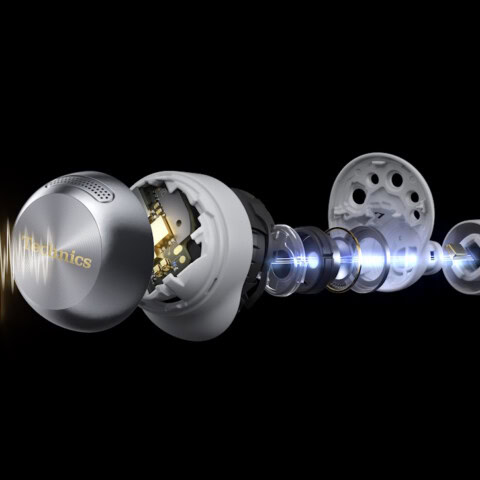$6000
5 Stars
Turbo-powered hybrid electrostatics are a wall-of-sound wonder
 For the past month, I’ve been faced with a dilemma. As dilemmas go, it’s pretty splendid, really. Oceania Audio kindly allowed me an unusually long audition of the entry-level Martin Logan product, the Purity. After a couple of months of putting these beauties through their paces, I can honestly say that the worst thing about them is their slightly bourgeois name. Meanwhile, I could fill a slim tome with turgid prose extolling their many virtues.
For the past month, I’ve been faced with a dilemma. As dilemmas go, it’s pretty splendid, really. Oceania Audio kindly allowed me an unusually long audition of the entry-level Martin Logan product, the Purity. After a couple of months of putting these beauties through their paces, I can honestly say that the worst thing about them is their slightly bourgeois name. Meanwhile, I could fill a slim tome with turgid prose extolling their many virtues.
But back to the dilemma: You see, I really, really can’t afford a new pair of loudspeakers right now, but the thought of returning these wonder audio emitters has me reaching for the proverbial Prozac.
What are they?
The Martin Logan Purity is a fully powered speaker, meaning that each speaker contains its own 200-watt ICE amplifier. More on that later. The tops and mids of the sound spectrum are dealt with by Martin Logan’s famed electrostatic panels, which give a very different experience to the listener than conventional cones. More on that later, too. The bass is dealt with by two six-inch woofers in a ported enclosure, and these go supernaturally deep. Keep reading.
Electrowhat?
Martin Logan is one of comparatively few speaker manufacturers worldwide that has invested its research into electrostatic panels. The American brand has won just about every audiophile award known to man or werewolf, and it hinges around those famous panels. I won’t bore the reader with an in-depth explanation of electrostatic speakers (that’s what Google is for, right?), but briefly, straight from the manual: “An electrostatic transducer consists of three pieces: stators, the diaphragm and spacers. The diaphragm is what actually moves to excite the air and create music. The stator’s job is to remain stationary, hence the word stator, and to provide a reference point for the moving diaphragm. The spacers provide the diaphragm with a fixed distance in which to move between the stators.”
Any the wiser? Continuing: “As your amplifier sends music signals to an electrostatic speaker, these signals are changed into two high-voltage signals that are equal in strength but opposite in polarity. These high voltage signals are then applied to the stators. The resulting electrostatic field, created by the opposing high voltage on the stators, works simultaneously with and against the diaphragm, consequently moving it back and forth, producing music. This technique is known as push-pull operation and is a major contributor to the sonic purity of the electrostatic concept due to its exceptional linearity and low distortion.”
What this means to the naked eye is a speaker in which everything except the bottom part (the bass drivers) is simply a see-through panel. No mid-range drivers or tweeter-cones to be seen. Visually, it’s pretty cool. What this means aurally is sound that is simply gobsmacking. Sitting in the sweet spot, the listener gets an amazing spread of sound from the speakers that’s almost non-directional, and so stereoscopic that it feels almost 3D. Where a good conventional speaker will throw the sounds around convincingly, the Purity works on an almost lysergic (psychedelic) level. Shut your eyes on the right piece of music, and it’s like “hearing” the night sky with all its little stars twinkling into infinity; an incredible sound stage that makes you wonder why anyone ever bothered with 5.1 “surround”.
 Basically, it mimics the effect of taking a nice long hit on a joint of wacky baccy, and as that’s something I haven’t done for decades, its nice to induce the effects of THC ingestion without breaking the law.
Basically, it mimics the effect of taking a nice long hit on a joint of wacky baccy, and as that’s something I haven’t done for decades, its nice to induce the effects of THC ingestion without breaking the law.
The other characteristic of electrostatics is clarity. These Martin Logans are certifiably forensic in their ability to expose and resolve intricate sonic details, to the point that around 90 percent of the albums I spun had substantial new details revealed that I hadn’t ever noticed before.
Points of difference
Where Martin Logan’s (and electrostatics in general) are power-hungry and very expensive, the Purity was created with a new audience in mind. The pricier Martin Logan’s are not only huge physically, but the electrostatics take care of all frequencies in some models. The Purity’s are a hybrid, meaning the lower frequencies are handled by conventional woofers. This isn’t a bad thing, because it means they’re easier to drive, and deliver punchier bass. Other unique features include the inbuilt 200-watt amplifiers inside the base of each speaker. These rather amazing ICE amps made by Bang & Olufsen provide a seamless, powerful and integrated signal, as one would expect. In practical terms, what the inboard power means is that the need for normal speaker wires is eliminated, and that has to be good. Instead, each speaker needs its own power cord, and RCA leads to a preamplifier. What this means is that if the purchaser happened to be unable to afford a nice preamp or CD player to go with the speakers, he/she need only plug in their iPod, computer or anything else with a built-in preamp. Of course, these devices won’t sound as good as a dedicated hi-res sound source, but you will still be astonished.
Essentially, then, with the Purity’s Martin Logan has attempted to make an affordable and adaptable speaker for a contemporary audience who may want to use it for a variety of purposes, and by including powerful amplifiers in the package, they have made the speakers incredibly good value for money.
Musique, non-stop
Over the course of two months, I challenged the Purity’s with an incredible variety of music, from classical through hard rock, intricate electronica through dub and pumping techno, acoustic guitar and piano through jazz and blues and “world” music. The Martin Logans astonished me over, and over, and over.
 To confirm that my ears weren’t made of cloth and that I wasn’t barking up the wrong tree, one night I nabbed my good wife for a blindfold test, in which I asked her to rate the Purity’s on a number of music selections compared to my other speakers. In all selections except for one, she preferred the Martin Logans. And so did I. My other speakers sounded more forgiving on the very compressed vocals of Madonna’s Confessions On A Dancefloor. [Hey, it wasn’t my choice, okay?] Ryuichi Sakamoto sounded more revealing, with more detailed nuance in the bass. Pink Floyd’s Dark Side Of The Moon sounded incredible. The remastered Magical Mystery Tour by the Beatles showed its age, but still came through with more detail, more clarity, and better bass. Tom Bailey’s introspective dub-electronica release, Seen, sounded superb and downright trippy, and really brought out the intricate layers of the best-engineered NZ electronic album to date. Janet Jackson’s Discipline [don’t laugh, it’s an incredible-sounding piece of Otara-oomph] brought out the layers of percussion, as well as the super-deep bass. Two of the best expositions of the Purity’s were these two: Cornelius’s incredible “Point” (from the album of the same name) showed the pin-point precision of the stereo imaging, and Eno’s Drawn From Life album was so lush and sound-sculptural that it seemed almost extra-sensory.
To confirm that my ears weren’t made of cloth and that I wasn’t barking up the wrong tree, one night I nabbed my good wife for a blindfold test, in which I asked her to rate the Purity’s on a number of music selections compared to my other speakers. In all selections except for one, she preferred the Martin Logans. And so did I. My other speakers sounded more forgiving on the very compressed vocals of Madonna’s Confessions On A Dancefloor. [Hey, it wasn’t my choice, okay?] Ryuichi Sakamoto sounded more revealing, with more detailed nuance in the bass. Pink Floyd’s Dark Side Of The Moon sounded incredible. The remastered Magical Mystery Tour by the Beatles showed its age, but still came through with more detail, more clarity, and better bass. Tom Bailey’s introspective dub-electronica release, Seen, sounded superb and downright trippy, and really brought out the intricate layers of the best-engineered NZ electronic album to date. Janet Jackson’s Discipline [don’t laugh, it’s an incredible-sounding piece of Otara-oomph] brought out the layers of percussion, as well as the super-deep bass. Two of the best expositions of the Purity’s were these two: Cornelius’s incredible “Point” (from the album of the same name) showed the pin-point precision of the stereo imaging, and Eno’s Drawn From Life album was so lush and sound-sculptural that it seemed almost extra-sensory.
So, I’d like to point out that my own speakers are no slouches. In fact, they’re superb, but to save them their dignity, I won’t name and shame them. The thing is, my own speakers do have sonic characteristics that make them very special, and they have a warmth that the Purity’s lack. But we’ll get to that in a minute.
To sum up about the sonic signature of the Purity’s: what I found over and over again was that their capacity for revealing detail was extraordinary, as was the spread of the sound. The electrostatics seem very well integrated with the bass drivers, which are fast, well-timed and substantially deeper than any floorstanding speakers I’ve heard in this price bracket. They’re so deep (but not in any way waffly) that they outperform my REL 10-inch subwoofer.
The buts, ifs and ahs
I know that this review might so far resemble a promotional exercise for Martin Logan, but it’s my honest opinion. To back that up, I’ll mention all the facets of the Purity’s that some consumers might have issues with.
About 10 percent of the albums I played sounded a little sharp. Not harsh, but sharp. This reflects both the electrostatic panels’ ability to show up deficiency in recordings, as well as the well-known fact that with electrostats, both exact positioning in a room and the room acoustics themselves are of prime importance.
In other words, some crap recordings are going to sound like crap on these speakers; there are speakers on the market that make crap recordings sound nice. But who wants that illusion?
I haven’t had the means to play around with these speakers, but am convinced that the right preamplifier could get these sounding a little warmer; ditto the interconnects, which are poor quality. If I had the cash to splash on these beauts, I’d put some work into my room, putting some sound absorbers on the walls behind the panels (the sound radiates forward and back, so there will be some bouncing off the walls).
Hmm, what else? Oh yes, positioning is key. If you’re someone who moves around the room a lot while listening to music, and is always sitting for a few minutes, then standing, these speakers are not for you. The Purity’s take some effort to get positioned just right for the ideal sweet spot (it’s worth the effort, believe me), and if you’re off centre, the illusion is gone. The electrostatic panels can only be heard properly in either the seated or standing position, but not both. In other words, if you stand up, you’ll notice there is no treble. The speaker’s feet can be swivelled so that they can be heard properly in standing position, but then when you sit down, the treble disappears. It’s an uncanny feeling, that the sound field is that precise to a certain radiant. I can reveal that one of Witchdoctor’s editors likes to bop around (dancing!) to his favourite Bronski Beat hits, so he could never live with the Martin Logan’s. Me? I like to sit in the sweet spot, close my eyes, clear my head of the day’s worries, and open up to the aural bliss of music; so I can deal with this peculiarity.
Apart from needing some time getting positioning just right, the Purity’s sound better in a slightly bigger room, or one where they can live at least two or three feet from back and side wall. This is true of nearly all hi-fi speakers, but it’s especially true with Martin Logan’s.
Nearly the end now…
The Martin Logan Purity’s are an exceptional speaker for a relatively modest price.
They have a few unusual facets that make them better suited to someone who really likes to sit down and listen, and their almost forensic level of musical detail will appeal to some more than others.
Personally, I found them a revelation with each successive listening session, and I loved the musical intricacies the Purity’s were capable of conveying, as well as their dynamism, punch and depth in the bass department, and that gloriously psychedelic sound field.
Very occasionally I detected a little “dryness”, especially in vocals; this could just be the price one has to pay for the astonishing detail, or it could be warmth obtainable via a valve preamp or vinyl source.
They’re a speaker with so much going for them (including the fact that they turn off automatically after 10 minutes when not in use, thereby saving power) that I’m already mortified at the thought of having to send them back.
In a word, the Martin Logan Purity’s are astonishing, and at their price point, I can’t think of a better deal out there. GARY STEEL
















Falsehoods and vile libel! Said editor doesn’t own any Bronski Beat albums, despite his affection for eighties music.
Hmm, he does look like the tall one from the Communards. Or maybe Vince from Yazoo…
Re the second photo: are you mad, feeding these beauties with compressed iPod music? Very helpful review, by the way.